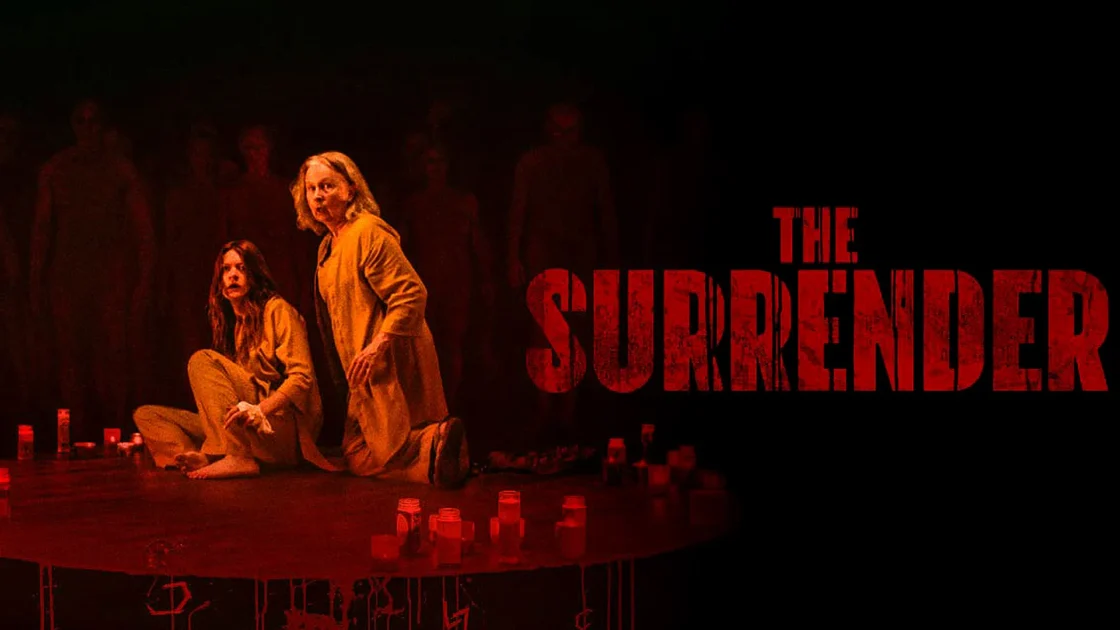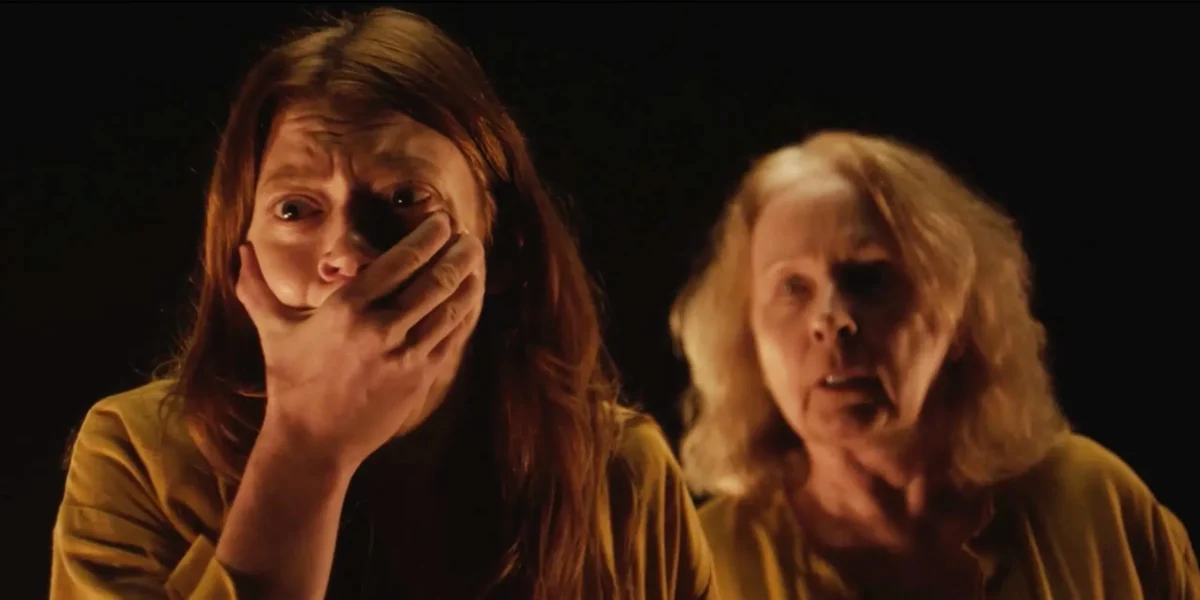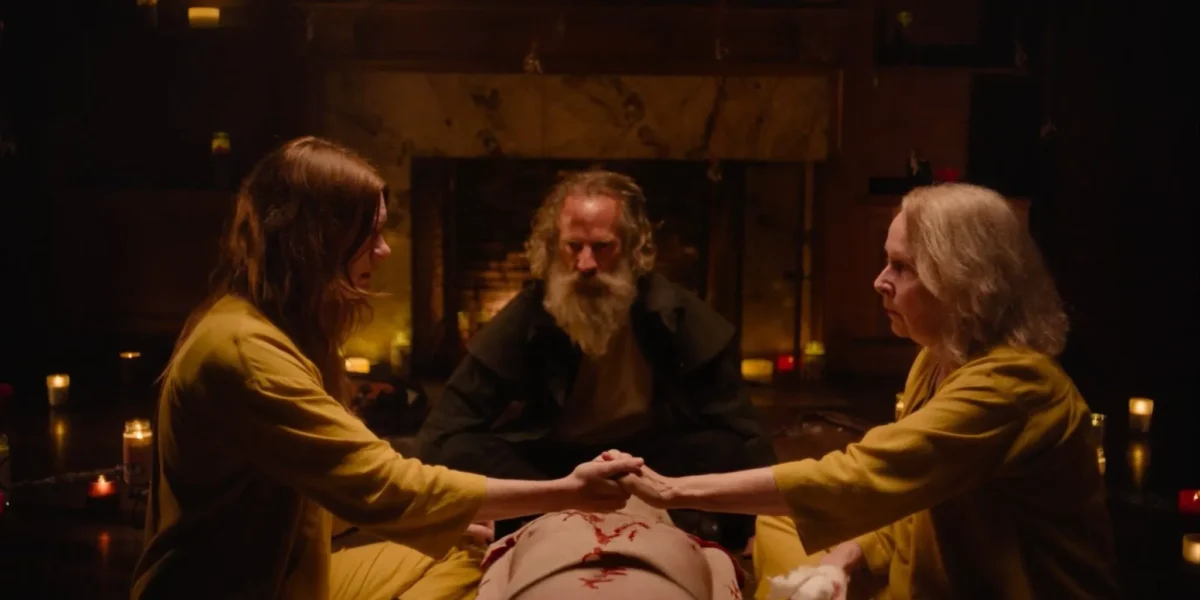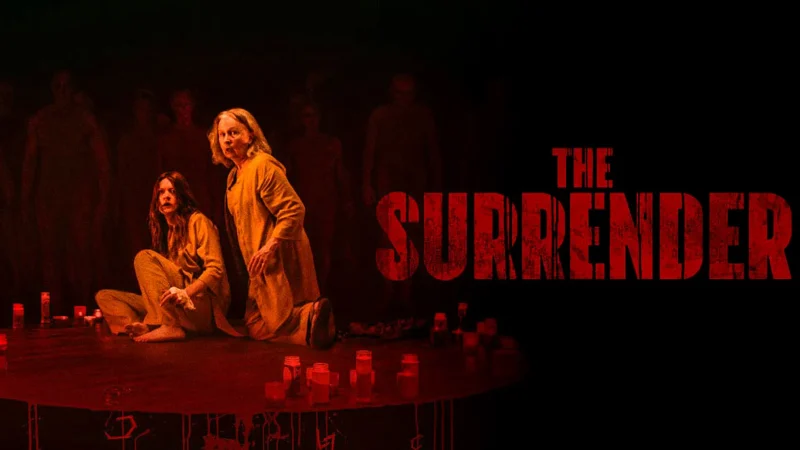The Surrender (2025): When Love Becomes a Cage and Death Offers No Escape
Julia Max’s “The Surrender” (2025) starring Colby Minifie and Kate Burton delivers psychological horror that examines toxic family relationships through the lens of supernatural resurrection. When patriarch Robert dies, his widow Barbara and daughter Megan perform a brutal ritual to bring him back, only to discover some monsters are better left dead. This Shudder exclusive combines beautiful cinematography with devastating emotional truth about cycles of abuse and the mythology we create around toxic love. A must-watch for fans of elevated horror that prioritizes psychological terror over cheap scares.

First of all, how exceptional is Colby Minifie? Her performances consistently deliver strength and ferocity, and while I approached “The Surrender” knowing only its premise, the opening sequence immediately establishes director Julia Max’s masterful wielding of atmospheric horror. The narrative wastes no time casting shadows over what initially appears to be a straightforward family drama. Before the opening credits conclude, we’re confronted with a grotesque tableau: a hunched, bone-filled creature consuming something unspeakable. Max’s camera work here demonstrates restraint, slowly revealing the monster’s human-like form before exposing a massive vertebral split that unexpectedly sprouts multiple sets of grasping fingers.
While this review avoids major plot reveals, some scenes and stylistic choices are discussed in detail. The final moments and an explanation of the ending of The Surrender is in a sealed section below. Proceed if you’re cool with that.
The Artistry of Emotional Manipulation
The film’s visual language speaks in rich, saturated colors and luminous cinematography that transforms even the darkest scenes into something aesthetically arresting. Whether capturing Barbara’s compulsive hair-weaving in her car, chalked up to stress but clearly signaling deeper psychological fractures, or focusing on her ritualistic adjustment of crystals hanging from curtains, every frame demands attention. This cinematography understands the power of selective focus, drawing our gaze exactly where it needs to be while leaving peripheral darkness.
Robert’s bedridden presence dominates the household dynamic from the opening moments, with Barbara’s spiritual journey manifesting in disturbing ways, human teeth collected in a medicine bag beneath his bed, much to daughter Megan’s visible displeasure. The dialogue brilliantly forces debates about healthcare, financial strain, and whether Robert should receive full morphine doses for his pain. According to his nurse, Barbara has become “a big problem,” but Max’s screenplay suggests the problem runs far deeper than grief-induced desperation.
The Mythology of Patriarchal Control
“He calls out for her because he’s in pain, not because he needs her,”
Megan observes, and this distinction becomes crucial to understanding the film’s exploration of emotional parasitism. Even in death, Robert’s character demands significant screen time, offering advice as a figment of Barbara’s imagination, convincing her that resurrection isn’t just possible but necessary. For a corpse, he certainly maintains considerable agency over the living.
The flashback sequences provide essential context about Robert’s true nature, slowly dismantling Megan’s idealized memories. Barbara, on the other hand, revels in everything about him.
“Even when someone dies, they don’t ever really go away”
Quote from the film “The Surrender”
Her father’s kind words become the only thing she hears, and it’s a comforting philosophy for Megan. For those watching, as Barbara remembers his actions, it becomes an ominous warning as the truth about Robert’s controlling, cruel nature emerges. He restricted Barbara’s clothing choices, dismissing them as “slutty,” and sabotaged Megan’s dance aspirations because “she couldn’t do everything.” These revelations transform the resurrection ritual from desperate love into something far more sinister.
The Economics of Emotional Blackmail
When Robert dies overnight, Barbara’s grief shifts into dangerous overdrive. Max wisely abandons traditional horror scoring for significant portions, allowing conversations to carry their full weight without musical manipulation. The silence becomes as oppressive as any orchestral stinger, particularly during the ritual preparation scenes where an incongruously gentle song replaces dialogue, creating unsettling reprieve while mother and daughter empty their home of everything except summoning materials.
The cast delivers exceptional performances, with Robert managing to embody two distinctly different characters, the living manipulator and the grotesque revenant. Kate Burton’s Barbara walks the knife’s edge between sympathetic grief and dangerous delusion, while Minifie’s Megan provides the audience’s rational anchor until even she becomes complicit in the madness.
The Surrender 2025 Ending Explained
“People save the worst parts of themselves for their spouses,” Barbara observes, and this truth becomes the film’s emotional foundation. When Megan discovers her entire inheritance has been liquidated for the resurrection ritual, her complete breakdown feels entirely justified. Her life’s work crumbles as she awaits grant funding that will never come, now sitting in a ritual circle preparing for blood sacrifice.
The film’s final act transforms into a meditation on cyclical abuse and the mythology we create around toxic relationships. Megan finds herself trapped in purgatory, a liminal space where she encounters dozens of lost souls, naked figures covered in white clay-like dust, who cannot hear her screams. The imagery here recalls classical depictions of Dante’s underworld, but Max’s vision feels distinctly contemporary in its psychological horror.
Most devastating are the repeated flashback sequences showing the same idealized memory: young Megan happy with her father, with no evidence of his cruelty or control ever surfacing. This selective memory becomes its own form of torture, repeating endlessly until she returns to the consuming darkness above. Her decision to hack off her fingers one by one, appeasing whatever entity claimed her mother, represents the ultimate surrender to the cycle of abuse that the title promises.
The film’s final revelation shows Robert’s true nature: a dominating presence who prevented both wife and daughter from experiencing joy or freedom. Barbara was isolated from friends, made to discredit her own morals and beliefs, because “abandoning your post is unappealing at best.” Megan finally sees this truth, understands her mother is gone forever, and chooses to destroy the protective circle, letting darkness claim victory.
“The Surrender” suggests that when those best parts were always an illusion, love becomes a cage that traps multiple generations. Megan’s final choice, destroying the circle and embracing darkness, reads as both defeat and liberation, the only honest response to recognizing that some prisons can only be escaped through complete surrender.

The Idolatry of Toxic Love
“The Surrender” functions as a devastating examination of how idolatry operates within abusive family structures. The psychological manipulation tactics Robert employs, even from beyond the grave, mirror patterns found across all power imbalances, from intimate relationships to institutional hierarchies. Like the exploitative dynamics seen in workplace thrillers such as “Whiplash” or “The Firm,” Max explores how victims become complicit in their own emotional imprisonment through systematic gaslighting disguised as care. The abuser creates an environment where questioning their methods is reframed as personal weakness, where isolation from outside perspectives becomes “focus,” and where the victim’s increasing desperation to prove their worth only tightens the psychological chains.
Robert’s posthumous hold over Barbara mirrors the toxic boss who convinces employees that their suffering is actually professional development, that their sacrifice proves dedication, and that leaving would mean throwing away everything they’ve “invested” in the relationship.
Barbara’s spiritual quest represents a common pattern where victims of emotional abuse seek increasingly desperate measures to resurrect the “good version” of their abuser, convincing themselves that if they just try hard enough, sacrifice enough, the person they fell in love with will return. The supernatural elements serve as a brilliant metaphor for this psychological reality: sometimes, the person you’re trying to bring back was never really there to begin with.
“Loving the best parts of someone is easy,”
Julia Max has crafted a horror film that understands the most terrifying monsters are often the ones we invite into our homes, our hearts, and our memories. “The Surrender” earns its scares through emotional truth rather than cheap jolts. While most horror fans will make do with the ending here, no doubt, others will be slightly irritated. How did you want it to end? Join the conversation on Mother of Movies on Facebook.
Rating: 4 out of 5 Resurrection rituals that should have stayed buried
Director: Julia Max Writer: Julia Max
Stars: Colby Minifie, Kate Burton, Chelsea Alden
Distributor: AMC/Shudder
Genre: Horror/Psychological Thriller
Runtime: PT1H26M | Released first in the United States on March 9, 2025 (SXSW Film Festival) before a wide release on May 23, 2025.

Streaming Options for The Surrender 2025
If You Like Possession Films, You Might Like
The Surrender

Director: Julia Max
Date Created: 2025-05-23 17:24
4
